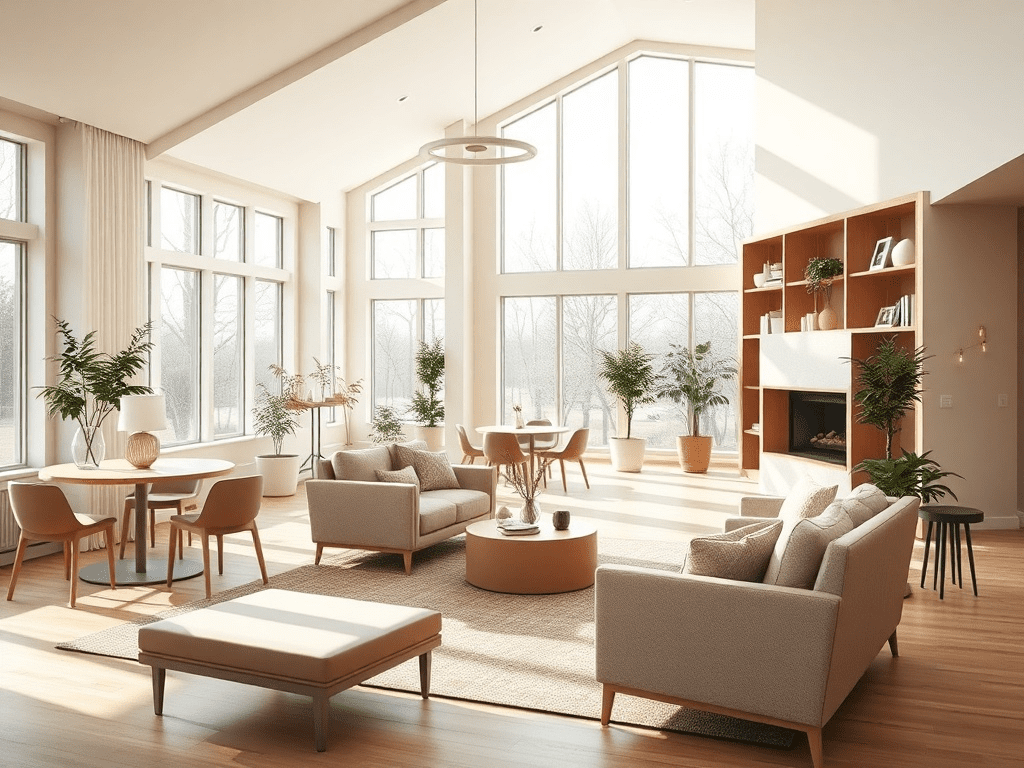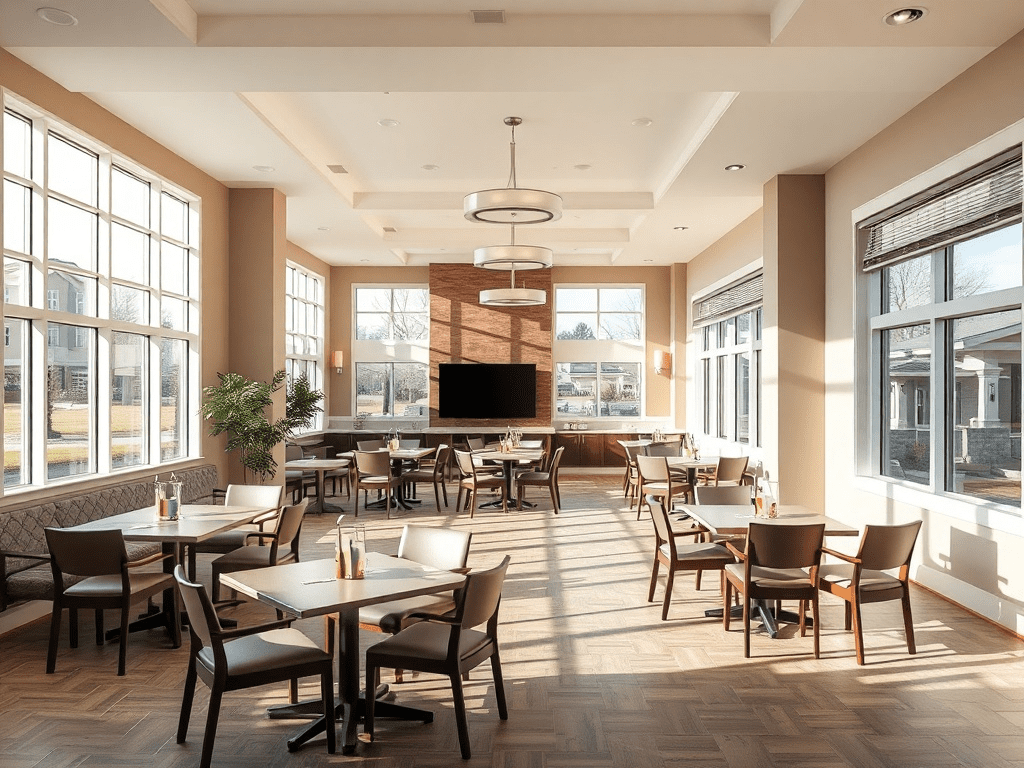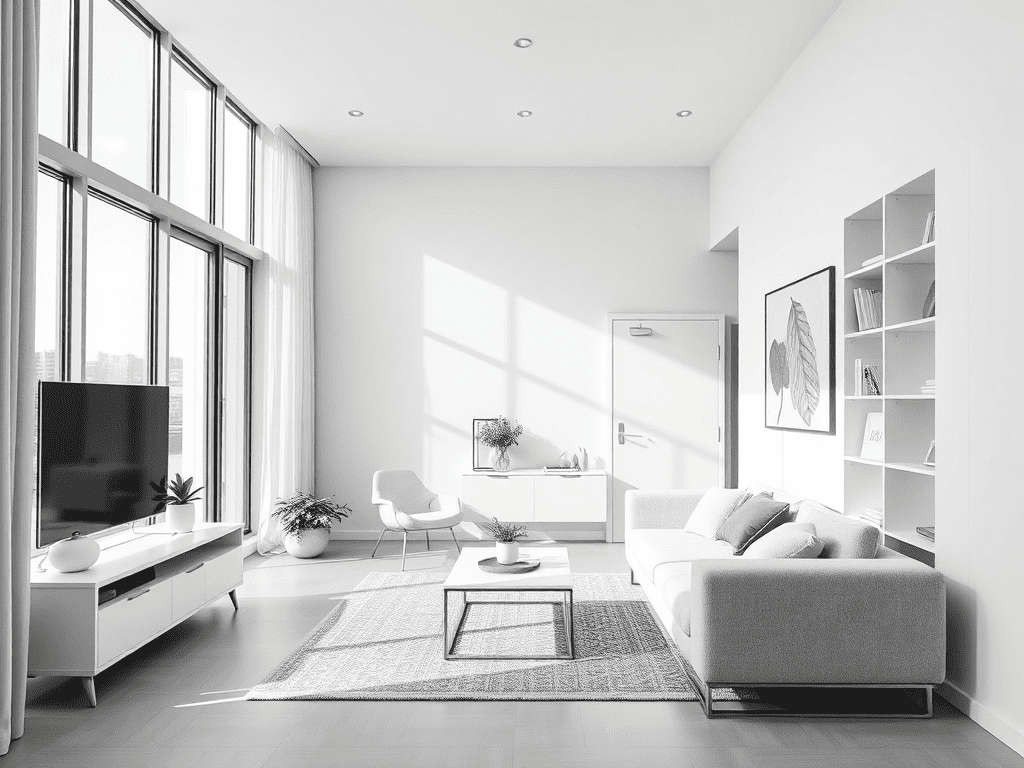Creating a comfortable, safe, and engaging environment is paramount when designing spaces for senior living. Thoughtful interior design for senior living can significantly enhance residents’ quality of life, promoting independence and well-being. This isn’t just about aesthetics; it’s about creating spaces that cater to the unique needs and challenges faced by seniors.
Why is Interior Design Important in Senior Living?
Interior design for senior living goes beyond mere decoration; it is intrinsically linked to the physical and emotional health of residents. A well-designed space can minimize fall risks, improve cognitive function, and foster a sense of community and belonging. By incorporating universal design principles for senior living, we can ensure that spaces are accessible and comfortable for everyone, regardless of their physical abilities.

Key Considerations for Safety in Senior Living Interior Design
Safety is the cornerstone of good interior design for senior living. Some crucial elements include:
- Non-slip flooring: Reduces the risk of falls, a leading cause of injury among seniors.
- Adequate lighting: Improves visibility and reduces the likelihood of accidents.
- Grab bars in bathrooms: Provide support and stability in a high-risk area.
- Rounded edges on furniture: Minimizes injury from bumps and falls.
Addressing these considerations proactively helps create a safer and more secure environment for senior residents. For example, the use of adaptive lighting can help regulate circadian rhythms and improve sleep quality.
How Does Lighting Play a Role in Interior Design for Senior Living?
Lighting is a critical element in interior design for senior living. As people age, their vision changes, often requiring brighter and more evenly distributed light. Natural light is ideal, but when that’s not possible, layered artificial lighting can mimic its effects. The best colors for senior living interior design often complement the lighting scheme, creating a warm and inviting atmosphere. Furthermore, avoiding glare and shadows is essential to prevent falls and disorientation.
What Types of Furniture are Best Suited for Senior Living Environments?
Furniture in senior living environments must be both functional and comfortable. Ergonomic designs that provide proper support are essential. Look for furniture with:
- Sturdy construction: Ensures stability and prevents tipping.
- Appropriate seat height: Makes it easier to sit and stand.
- Easy-to-clean materials: Simplifies maintenance and hygiene.
- Minimalist design: Reduces clutter and potential hazards.
Accessible interior design for senior living prioritizes these features to promote independence and reduce the risk of falls. Selecting the right furniture contributes significantly to the overall well-being of residents.

How Does Interior Design Contribute to a Sense of Community in Senior Living Facilities?
Thoughtful interior design for senior living can foster a sense of community by creating inviting and accessible common areas. Comfortable seating arrangements, well-lit activity spaces, and aesthetically pleasing décor can encourage social interaction and engagement. Consider:
- Multipurpose rooms: Adaptable spaces for various activities and gatherings.
- Shared dining areas: Promote socialization and a sense of belonging.
- Outdoor spaces: Offer opportunities for fresh air and recreation.
Biophilic interior design for senior living, which incorporates natural elements like plants and natural light, can further enhance the sense of well-being and connection to the environment. As detailed in a study by Frontiers in Psychology, exposure to nature can reduce stress and improve cognitive function.
The Cost of Interior Design for Senior Living Facilities
The cost of interior design for senior living facilities varies widely depending on the scope of the project, the size of the facility, and the specific materials and furnishings chosen. While it may seem like a significant investment, the long-term benefits – improved resident well-being, reduced fall risks, and enhanced property value – often outweigh the initial costs. Sustainable interior design for senior living can also lead to long-term cost savings through energy efficiency and reduced maintenance.
FAQ: Interior Design for Senior Living
What is interior design for senior living?
Interior design for senior living is the specialized practice of creating living spaces that are safe, comfortable, and supportive for elderly residents. It considers the unique physical, cognitive, and emotional needs of seniors to enhance their quality of life and independence.
Why is interior design for senior living important for residents’ well-being?
It enhances well-being by minimizing fall risks, improving cognitive function, fostering a sense of community, and promoting independence. Thoughtful design can create a more comfortable and engaging environment for residents.
What are the key considerations for safety in senior living interior design?
Key safety considerations include non-slip flooring, adequate lighting, grab bars in bathrooms, rounded furniture edges, and clear pathways to prevent falls and accidents. These are crucial elements of accessible interior design for senior living.
How does lighting play a role in interior design for senior living?
Lighting improves visibility, reduces glare and shadows, and can regulate circadian rhythms. Layered lighting, including natural and artificial sources, can create a well-lit and comfortable environment, according to the Illuminating Engineering Society.
What types of furniture are best suited for senior living environments?
Ergonomic furniture with sturdy construction, appropriate seat height, easy-to-clean materials, and minimalist design is best suited for senior living environments. These features enhance comfort and safety.
How does interior design contribute to a sense of community in senior living facilities?
Interior design fosters community by creating inviting and accessible common areas, comfortable seating arrangements, and aesthetically pleasing décor that encourages social interaction and engagement.
How does the cost of interior design for senior living compare to standard interior design projects?
The cost can vary, but senior living design often requires specialized knowledge and materials to address safety and accessibility concerns, which may increase the overall investment compared to standard design projects.
How can color schemes improve the mood and cognitive function of seniors in senior living spaces?
Calming color schemes with soft, muted tones can improve mood and reduce agitation. Colors like blues, greens, and creams are often used to create a relaxing and therapeutic environment, which is particularly important in interior design for senior living dementia settings.
Interior Design for Small Senior Living Apartments
Even interior design for small senior living apartments can make a big impact. Maximizing space, using multifunctional furniture, and incorporating personal touches can create a comfortable and inviting home. Vertical storage solutions and light, airy color palettes can help make small spaces feel larger and more open.

Modern Interior Design for Senior Living Communities
Modern interior design for senior living communities focuses on creating stylish, contemporary spaces that cater to the evolving tastes of today’s seniors. Clean lines, minimalist décor, and pops of color can create an upscale and engaging environment. These designs often incorporate smart home technology to enhance convenience and safety.
Interior Design for Senior Living Memory Care
Interior design for senior living memory care requires a specialized approach to create a calming and secure environment for residents with cognitive impairments. Simple layouts, clear visual cues, and familiar objects can help reduce confusion and anxiety. As noted by the Alzheimer’s Association, creating a safe and supportive environment is crucial for memory care patients.
Examples of Senior Living Interior Design
Looking at examples of senior living interior design can provide inspiration and practical ideas for creating comfortable and safe spaces. From modern apartments to cozy common areas, the possibilities are endless.
Interior Design for Senior Living Bathrooms
Interior design for senior living bathrooms focuses on safety and accessibility. Grab bars, walk-in showers, and raised toilets are essential features. Non-slip flooring and adequate lighting are also crucial to prevent falls.
What are the best interior design choices for senior living?
The best interior design choices prioritize safety, comfort, and accessibility, and promote well-being. These choices include thoughtful use of color, lighting, and furniture, as well as the integration of universal design principles and biophilic design.
How can interior design help seniors live independently?
Interior design can help seniors live independently by creating spaces that are easy to navigate, safe to use, and promote a sense of confidence and autonomy.
Where can I find examples of interior design for senior living?
You can find examples of interior design for senior living in design magazines, online design galleries, and by visiting senior living communities in your area.
By prioritizing safety, comfort, and engagement, interior design for senior living can significantly enhance the quality of life for residents, promoting independence, well-being, and a strong sense of community.
| Consideration | Benefit | Example |
|---|---|---|
| Non-slip Flooring | Reduces fall risk | Textured vinyl or rubber flooring |
| Adequate Lighting | Improves visibility | Layered lighting with adjustable brightness |
| Ergonomic Furniture | Enhances comfort and support | Chairs with armrests and lumbar support |
| Calming Color Schemes | Improves mood | Pastel blues and greens |


